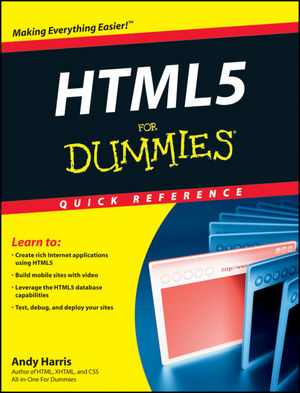HTML5 For Dummies Quick ReferenceISBN: 978-1-118-01252-9
Spiral-bound paperback
224 pages
May 2011
 This title is out-of-print and not currently available for purchase from this site.
|
A Quick History of HTML.
A bit of ancient history.
And the first browser war begins.
A new challenger arises from the ashes.
HTML 4 was getting old.
Getting to Know the Real HTML5.
HTML5 Is More than HTML!
HTML.
CSS.
JavaScript.
Server technologies.
Looking At Browser Features.
Assessing your browser’s capabilities.
Checking for features in your code.
Picking a Suitable Browser.
Using Chrome Frame to Add Support to IE.
Part 2: HTML Foundations.
Exploring HTML and XHTML.
Appreciating HTML.
Emergence of XHTML.
It’s alive, and it’s HTML5!
Setting up a basic HTML page.
Fleshing Out Your Page.
Adding images.
Including links.
Making lists and tables.
Utilizing tables.
Making a Form.
Form structure tags.
Constructing text input.
Creating password fields.
Erecting a multiline text box.
Forming drop-down lists.
Making checkboxes.
Popping in radio buttons.
Putting in action buttons.
Validating Your Pages.
Part 3: New or Changed HTML5 Elements.
Semantic Page Elements.
address.
article.
aside.
footer.
header.
hgroup.
menu.
nav.
section.
Inline Semantic Elements.
command.
details.
dfn.
figcaption.
figure.
summary/details.
time.
wbr.
Media Elements.
audio.
canvas.
embed.
source.
svg.
video.
Ruby Elements.
ruby.
rt.
rp.
Part 4: New and Modified Form Elements.
New Form Elements.
datalist.
fieldset.
keygen.
label.
meter.
output.
progress.
New Form Element Attributes.
autofocus.
pattern.
placeholder.
required.
Validation.
New Form Input Types.
color.
date.
datetime.
datetime-local.
email.
month.
number.
range.
search.
tel.
time.
url.
week.
Part 5: Formatting with CSS.
A Quick Overview of CSS.
Employing local styles.
Making use of ids and classes.
Managing levels of CSS.
Managing the Appearance of Your Page.
Comprehending hex colors.
Editing text.
Joining the border patrol.
Putting in background images.
Using Float Positioning.
Getting to know the display types.
Having a block party.
Floating to a two-column look.
Cleaning up the form.
Using absolute positioning.
Part 6: New and Improved CSS Elements.
CSS3’s New Selection Tools.
Attribute selection.
not.
nth-child.
Other new pseudo-classes.
Downloadable Fonts and Text Support.
@font-face.
Column support.
text-stroke.
text-shadow.
Flexible Box Layout Model.
Creating a flexible box layout.
Viewing a flexible box layout.
. . . And now for a little reality.
New Visual Elements.
Color values.
Gradients.
Image borders.
Reflections.
Rounded corners.
Shadows.
Transformations.
Transition animation.
Transparency.
Part 7: Changes in JavaScript.
Behold: The New JavaScript Selection Options.
document.getElementsByClassName( ).
document.getElementsByTagName( ).
document.querySelector( ).
document.querySelectorAll( ).
Data Options.
Achieving offline cache.
Local storage.
WebSQL database.
Miscellaneous New JavaScript Features.
Geolocation.
Notifications.
Web sockets.
Web workers.
Part 8: Working with the Canvas.
Canvas Basics.
Setting up the canvas.
Understanding how canvas works.
Controlling Fill and Stroke Styles.
Colors.
Gradients.
Patterns.
Drawing Essential Shapes.
Drawing rectangles.
Drawing text.
Enhancing shapes with shadows.
Drawing More Complex Shapes.
Line-drawing options.
Making arcs and circles.
Making quadratic curves.
Producing a bezier curve.
Images.
Drawing an image on the canvas.
Drawing part of an image.
Manipulating Images with Transformations.
Building a transformed image.
Some key points about transformations.
Using Animation.
Basic structure of the animation loop.
Creating the constants.
Deploying the animation.
Giving animation to the current frame.
Moving an element.
Now we’re bouncing off the walls.
Working with Pixel Manipulation.
Index.



